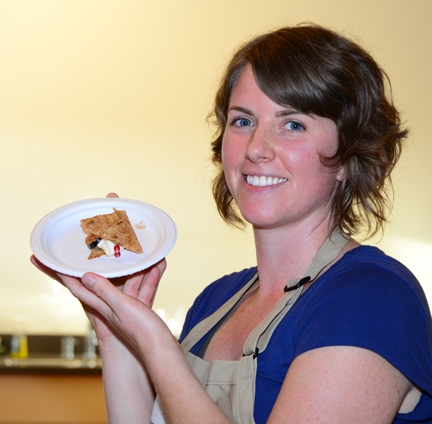
And honey? The Golden State ranks second in honey production, eclipsed only by North Dakota.
So why not combine all of them into a dessert? And add some walnuts and goat cheese for good measure--and good taste?
That’s exactly what Julie Loke of the Davis Food Co-Op did at the debut event of the newly established Honey and Pollination Center of the Robert Mondavi Institute for Wine and Food Science (RMI) at UC Davis.
The event, held Oct. 27 in the RMI’s Silverado Vineyards Sensory Theatre, drew talks on honey and pollination, and showcased a bee observation hive from the Harry H. Laidlaw Jr. Honey Bee Research Facility.
The Honey and Pollination Center, approved earlier this year by the UC Davis College of Agricultural and Environmental Sciences, aims to “make UC Davis the nation’s leading authority on honey, honey bees and pollination by combining the resources and expertise of RMI and the Department of Entomology’s Harry H. Laidlaw Jr. Honey Bee Research Facility,” said RMI executive director Clare Hasler-Lewis.
The center's goals include:
- Expand research and education concerning nutrition, health, quality and appreciation of honey
- Develop useful information for California’s agricultural bounty that depends on insect pollination
- Help the honey industry establish labeling guidelines to guarantee pure and unadulterated varietal honey
- Coordinate a multidisciplinary team of experts in honey production, pollination and bee health
- Promote the use of locally procured honey in the home, food industry and restaurants
Loke, the Davis Co-Op Teaching Kitchen coordinator, says she’s been obsessed with food for as long as she can remember. With 10 years of experience following “foodie adventures” (her repertoire includes running a kitchen on an eco-cruise, working in an organic garden, and teaching kids how to cook from scratch), she now teaches cooking classes at the Davis Co-Op, where she works full-time doing marketing, education and events.
The pomegranate is one of her favorite new foods.
“I’m from the East Coast and Midwest and had very little exposure to them growing up,” she said. “I love the act of breaking open the skin and having the arils (the juicy seeds) pop out, like a beautiful present! I love to eat them just out of hand but have incorporated them in everything from grains with toasted almonds to tossing them in most any salad and especially in desserts for a fun pop of tartness."
So when Loke delivered her presentation on how to make Baklava-Inspired Napoleans with fresh figs, pomegranate, honey and chevre mousse - and then served the dessert to the crowd - the crowd clamored for more.
This pastry serves 6 to 8 people, but “depending on how you cut the baklava and how much mousse you use, it could feed even more,” Loke says. She describes it as "crispy layers of phyllo dough, walnuts and spices, balanced atop dollops of tangy goat cheese mousse with fresh local figs, drizzled in California orange blossom honey."
Baklava Inspired Napoleans with Fresh Figs, Pomegranate, Honey and Chevre Mousse
Ingredients:
1/2 stick of butter
10 sheets whole wheat phyllo dough, thawed
10 fresh figs, sliced into thinnish rounds or thin wedges, tossed in a little thinned honey
2 cups chevre mousse (see recipe below)
1/4 cup honey, such as Moonshine Trading Company’s California orange blossom
1 cup finely chopped raw walnuts or pistachios
1/2 cup raw sugar
1 teaspoon cinnamon
1/4 teaspoon nutmeg
1/4 teaspoon allspice
Directions:
Thaw phyllo dough in the refrigerator overnight. Pre-heat oven to 400 degrees. You can melt the butter in the preheating oven or in short bursts in the microwave or in a pan on the stove—watch it closely. Set aside in a warm spot on the stove.
In a food processor, finely mince the nuts, sugar and all of the spices. It should be fairly fine easy to sprinkle over the dough. Or chop by hand and mix. Set aside. This will be layered between each sheet of phyllo dough. Prepare two sheet pans that are large enough to hold the phyllo sheets or close to it; you can always trim the phyllo to fit. Gently unwrap the phyllo and cover with a clean, damp fuzz-free dishtowel. Lift a whole sheet of phyllo from the pile and carefully lay out over the sheet pan. Replace the damp dishtowel over the pile. Using a pastry brush, lightly butter the first layer and lightly sprinkle with the spiced nut filling. Repeat and continue until you’ve done 4 sheets. Now carefully cut into 4-inch x 4-inch squares, or any other size or shape you can imagine. Then repeat the whole process on the other pan. Place into a 400 degree oven for about 10 minutes, or until golden brown and flaky. Let cool and then using your figs, honey and chevre mousse, layer into little towers. Drizzle all over with honey.
Chevre Mousse
1/2 cup heavy cream
1/4 cup goat cheese (chevre), room temperature
1 teaspoon pure vanilla extract and/or orange zest
2 tablespoons sugar
In a mixing bowl, whip the goat cheese with the whisk attachment until it starts to soften. Add the cream and orange zest and continue mixing until soft peaks just begin to form. Be careful you don’t overheat.
(Editor's note: If a pomegranate perplexes you, Julie Loke will be teaching a short introductory class on pomegranates at 6 p.m. Wednesday, Jan. 9, in the teaching kitchen of the Davis Food Co-op. She’ll show folks how to select, cut open, and juice pomegranates, and she'll provide a few recipes as well. The cost is $7. See http://davisfood.coop/education/cookingclasses.)
Attached Images:

California is the sole producer of 99 percent of the pomegranates grown in the United States. (Photo by Kathy Keatley Garvey)

This bee observation hive from the Harry H. Laidlaw Jr. Honey Bee Research Facility was showcased at the Honey and Pollination Center event. (Photo by Kathy Keatley Garvey)

Close-up of Baklava-Inspired Napoleans. (Photo by Kathy Keatley Garvey)